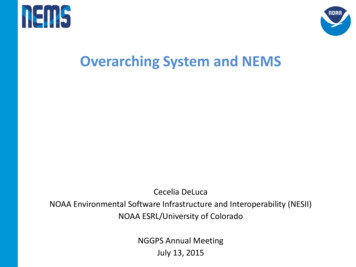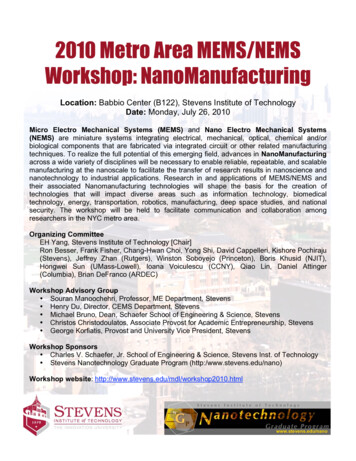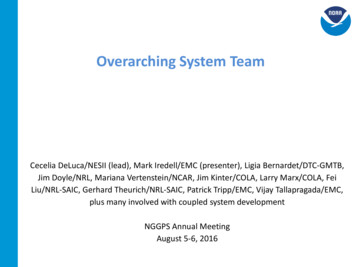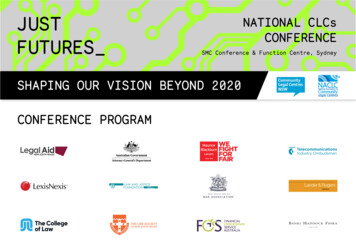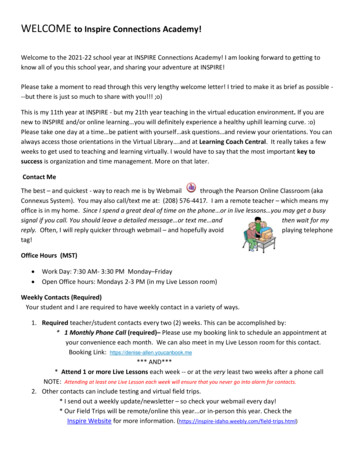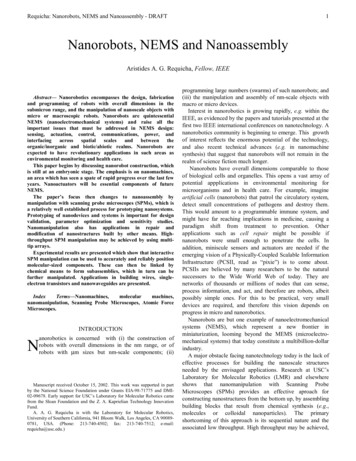
Transcription
Requicha: Nanorobots, NEMS and Nanoassembly - DRAFT1Nanorobots, NEMS and NanoassemblyAristides A. G. Requicha, Fellow, IEEE Abstract— Nanorobotics encompasses the design, fabricationand programming of robots with overall dimensions in thesubmicron range, and the manipulation of nanoscale objects withmicro or macroscopic robots. Nanorobots are quintessentialNEMS (nanoelectromechanical systems) and raise all theimportant issues that must be addressed in NEMS design:sensing, actuation, control, communications, power, nic/inorganic and biotic/abiotic realms. Nanorobots areexpected to have revolutionary applications in such areas asenvironmental monitoring and health care.This paper begins by discussing nanorobot construction, whichis still at an embryonic stage. The emphasis is on nanomachines,an area which has seen a spate of rapid progress over the last fewyears. Nanoactuators will be essential components of futureNEMS.The paper’s focus then changes to nanoassembly bymanipulation with scanning probe microscopes (SPMs), which isa relatively well established process for prototyping nanosystems.Prototyping of nanodevices and systems is important for designvalidation, parameter optimization and sensitivity studies.Nanomanipulation also has applications in repair andmodification of nanostructures built by other means. Highthroughput SPM manipulation may be achieved by using multitip arrays.Experimental results are presented which show that interactiveSPM manipulation can be used to accurately and reliably positionmolecular-sized components. These can then be linked bychemical means to form subassemblies, which in turn can befurther manipulated. Applications in building wires, singleelectron transistors and nanowaveguides are nes,nanomanipulation, Scanning Probe Microscopes, Atomic ForceMicroscopes.INTRODUCTIONanorobotics is concerned with (i) the construction ofrobots with overall dimensions in the nm range, or ofrobots with µm sizes but nm-scale components; (ii)NManuscript received October 15, 2002. This work was supported in partby the National Science Foundation under Grants EIA-98-71775 and DMI02-09678. Early support for USC’s Laboratory for Molecular Robotics camefrom the Sloan Foundation and the Z. A. Kaprielian Technology InnovationFund.A. A. G. Requicha is with the Laboratory for Molecular Robotics,University of Southern California, 941 Bloom Walk, Los Angeles, CA 900890781, USA. (Phone: 213-740-4502; fax: 213-740-7512; e-mail:requicha@usc.edu.)programming large numbers (swarms) of such nanorobots; and(iii) the manipulation and assembly of nm-scale objects withmacro or micro devices.Interest in nanorobotics is growing rapidly, e.g. within theIEEE, as evidenced by the papers and tutorials presented at thefirst two IEEE international conferences on nanotechnology. Ananorobotics community is beginning to emerge. This growthof interest reflects the enormous potential of the technology,and also recent technical advances (e.g. in nanomachinesynthesis) that suggest that nanorobots will not remain in therealm of science fiction much longer.Nanorobots have overall dimensions comparable to thoseof biological cells and organelles. This opens a vast array ofpotential appplications in environmental monitoring formicroorganisms and in health care. For example, imagineartificial cells (nanorobots) that patrol the circulatory system,detect small concentrations of pathogens and destroy them.This would amount to a programmable immune system, andmight have far reaching implications in medicine, causing aparadigm shift from treatment to prevention. Otherapplications such as cell repair might be possible ifnanorobots were small enough to penetrate the cells. Inaddition, miniscule sensors and actuators are needed if theemerging vision of a Physically-Coupled Scalable InformationInfrastructure (PCSII, read as “pixie”) is to come about.PCSIIs are believed by many researchers to be the naturalsuccessors to the Wide World Web of today. They arenetworks of thousands or millions of nodes that can sense,process information, and act, and therefore are robots, albeitpossibly simple ones. For this to be practical, very smalldevices are required, and therefore this vision depends onprogress in micro and nanorobotics.Nanorobots are but one example of nanoelectromechanicalsystems (NEMS), which represent a new frontier inminiaturization, looming beyond the MEMS (microelectromechanical systems) that today constitute a multibillion-dollarindustry.A major obstacle facing nanotechnology today is the lack ofeffective processes for building the nanoscale structuresneeded by the envisaged applications. Research at USC’sLaboratory for Molecular Robotics (LMR) and elsewhereshows that nanomanipulation with Scanning ProbeMicroscopes (SPMs) provides an effective aproach forconstructing nanostructures from the bottom up, by assemblingbuilding blocks that result from chemical synthesis (e.g.,molecules or colloidal nanoparticles). The primaryshortcoming of this approach is its sequential nature and theassociated low throughput. High throughput may be achieved,
Requicha: Nanorobots, NEMS and Nanoassembly - DRAFThowever, by massively parallel assembly operations usingSPM multi-tip arrays, which are built by MEMS techniques.For example, an IBM group is building multi-tips for digitalstorage applications that are expected to achieve densities onthe order of a few Tb/in2 [ Vettiger et al. 2002].Single-tip SPM manipulation will be very useful for theforeseeable future as a device prototyping technique.Regardless of how a nanodevice will eventually be massproduced, prototyping is needed to ensure that the device willwork as intended, and to optimize its parameters. Thecharacteristics of a device, e.g. its geometry, often can bealtered easily by nanomanipulation, to study the sensitivity ofthe device to parameter variations. This is usually difficult todo by using self-assembly or other construction processes.Single-tip nanomanipulation may also be used to repair orsystematically modify structures built by other means.Therefore, SPM nanomanipulation is undoubtedly here to stay.The remainder of this paper is divided into two majorsections. The first deals with nanorobot and NEMSconstruction, with an emphasis on nanoactuators, an area thathas seen rapid development in the last few years and is ofprimary importance for future NEMS. The second sectionfocuses on nanomanipulation with SPMs. Programming ofrobot swarms and PCSIIs are complex topics that deserveseparate treatment and are not covered in depth in this paper.I. NANOROBOTS AND NEMSA. BackgroundNanorobots, nanomachines and other nanosystems discussedin this paper are objects with overall sizes on the order of afew micrometers or less in all three spatial directions, andwhich are assemblies of nanoscopic components withindividual dimensions 1-100 nm. Medical nanodevicestraveling in the human body for therapeutic purposes havecaptured the public’s imagination at least since the times of theold “Fantastic Voyage” movie (Twentieth Century Fox, winnerof the 1966 Oscar for best visual effects). Order-of-magnitudefeasibility calculations [Drexler 1992, Freitas 1999] indicatethat nanorobots are not physically impossible. They would beextremely useful not only in the medical field but also inapplications such as (i) monitoring and interacting withharmful microorganisms in the air or in water and (ii) buildingintelligent surfaces with a controllable (programmable)structure, e.g., with variable roughness and friction. However,artificial nanorobots do not exist today, primarily because ofthe difficulties in building the necessary nanostructures. Theonly extant nanorobotic systems are biological, and provide anexistence proof that such systems are indeed feasible.Nanorobotics and, more generally, NEMS research involvesdesign (which often is biologically inspired), prototyping,fabrication, programming, and applications such as biomedicalnanotechnology.Robotics at any scale involves sensing; control; actuationand propulsion; power; communications; interfacing; andprogramming and coordination. In the following sections we2discuss some of these issues, with an emphasis on actuation,which is a fundamental requirement for robotics. (We use theterms “machine”, “motor” and “actuator” as synonymous inthis paper.) We will often look towards biology, e.g. tomicroorganisms such as bacteria, to see how evolution hassolved some of the problems that nanorobots will encounter.B. SensorsArtificial sensors that are truly nanoscopic do not yet exist,as far as we know. A device that exploits the change inconductivity of a carbon nanotube when it is exposed to aspecific gas is perhaps the closest to a true nanosensor [Konget al. 2000]. Although the nanotube used in this sensor isseveral microns long, it should be possible to make it shorterand still keep its sensing capabilities.Chemical sensors based on microscopic cantilevers arebeing investigated by several research groups, and often callednanosensors, but they are really microscale devices [Fritz et al.2000, Thundat et al. 2000]. Tactile (force) sensing usingfunctionalized SPM cantilevers is being investigated at LMRfor applications in identification of marine microorganisms.Chemical sensing using similar techniques has already beendemonstrated, e.g. by Hinterdorfer’s group at the university ofLinz [Hinterdorfer et al. 1996]. It may be possible tominiaturize these approaches by using nanoscale cantilevers,but this has not been done yet, as far as we know.Bacteria may use sensors for such stimuli as magnetic fieldsor light, but mostly they sense chemical concentrations byusing molecular transduction mechanisms. These chemicalsensors require contact between the bacteria’s receptors andthe sensed chemicals. Macrorobot sensing strategies fornavigation and other applications normally use sensormodalities such as sonar, which do not require physical contactwith the sensed objects. Strategies that relie only on contactsensing have not been studied, as far as we know.C. Actuators1) Artificial Molecular MachinesThere has been significant progress in the design andchemical synthesis of molecular machines in the last fewyears—see e.g. the surveys in [ACR 2001, Balzani et al.2000]. These machines are either single molecules orsupramolecular systems of interlocked molecules. In eithercase, they are atomically precise, that is, each atom is in aknown and precisely established location with respect to theothers. Power is supplied to these machines electrically,optically, or chemically by feeding them with some givencompound. Chemical power tends to be inconvenient becauseit cannot be easily switched on or off—a machine will moveuntil it runs out of fuel—and normally produces wasteproducts that must be eliminated. Two of the most interestingmolecular machines synthesized to date are light-driven smallorganic molecules: a linear shuttle [Brower et al. 2001] and arotary motor [Feringa 2001]. Under irradiation with a suitablewavelength in the visible range one part of Feringa’s molecule(the rotor) rotates continuously with respect to a fixed part (the
Requicha: Nanorobots, NEMS and Nanoassembly - DRAFTstator) around a carbon-carbon double bond. The rotationproceeds in four steps. First the light causes a so-called cistrans isomerization. This is a change of conformation (shape)of the molecule from a state in which two groups (of atoms)are on the same side of a bond (cis) to another in which thegroups are on opposite sides of the bond (trans). The resultingconformation is unstable and spontaneously changes to a moreenergetically-favorable conformation, continuing the rotation.This is step 2. Steps 3 and 4 are similar to 1 and 2. In step 3the light produces another cis-trans isomerization with anunstable result that spontaneously decays to the intialconformation, thus closing the cycle.The work on molecular machines is very interesting but inits current form has some drawbacks from the point of view ofapplications in nanosystems: The machines are synthesized and exist in solution. To beable to address each of them individually it seemsnecessary to attach them to a surface or perhaps to a 3-Dstructure. Moving back and forth or rotating continuously withoutbeing attached to a load is not very useful. In general, themoving elements must be connected, or coupled, to otherstructures. The yield of an operation is usually much less than 100%.Thus, for example, if we apply radiation of the appropriatewavelength to a solution containing light-driven molecularmotors, only 10-50% actually move. Design ofmechanical systems with such a high tolerance for failureis very uncommon. Many of the molecules used in these machines are notrigid, whereas most of the design techniques formechanisms at the macroscopic scale ignore flexibility. Chemical fueling is inconvenient and produces waste thatmust be removed. Light control may affect many machines because thewavelength of light is much larger than an individualmachine. Electrical control typically requires eguides [Maier et al. 2001] and nanowires[Meltzer et al. 2001] may help here. The force/torque and energy characteristics of thesemachines have not been investigated in detail.2) BiomotorsAnother approach to mechanical nanosystem designinvolves harvesting (modified) biological motors. Biomotorstend to be on the range of 10s of nm, and are typically largerthan the synthetic molecular machines discussed above, whichhave overall sizes of only a few nm. Noji and co-workers werethe first to directly image the motion of a biomotor [Noji et al.1997]. They attached the F1-ATPase motor to a surface andalso to a large actin filament that was visible in an opticalmicroscope. Several laboratories are conducting interestingresearch on the applications of harvested biomotors tonanosystems—see e.g. [Montemagno & Bachand 1999,Dennis et al. 1999].3Artificial motors built with biological materials have alsobeen demonstrated. Typically they exploit certain properties ofDNA. Seeman’s group has reported an actuator that exploits atransition between two types of DNA [Yan et al. 2002], and aBell Labs group has reported another actuator that exploits thetendency of short DNA segments to assume a rigid, linearconformation [Simmel & Yurke 2001]. The Bell Labs machineis similar to a tweezer, which opens and closes when certainDNA strands are introduced in the solution.Because biomotors have been successfully attached tosurfaces and to loads, they are closer to applications than thesynthetic molecular machines. But they are not withoutproblems: They run on chemical fuel (usually ATP), which has thedrawbacks mentioned earlier. They are made of soft materials of limited durability. They operate in a narrow range of environmentalconditions (e.g., temperature and pH). They are hard to control. They are very complex, and much is still unknown abouttheir structure and operation.3) Other NanomachinesLarger, not atomically-precise machines have also beendemonstrated. Here the most interesting is perhaps a veryrecent nanotweezer development in Scandinavia [Bøggild etal. 2001]. This nanotweezer is based on a MEMS electrostaticmotor with two cantilevers that bend under an applied voltage.Two very thin probes are grown on the tips of the cantileversby deposition of carbonaceous material in a SEM (ScanningElectron Microscope). Gaps between tips as low as 20 nmhave been demonstrated. The nanotweezer could, in principle,be used to grasp nanoobjects and manipulate them in 3-D.This, however, has not yet been reported in the literature. Anearlier nanotweezer built by glueing two carbon nanotubes to aprobe was reported in [Kim & Lieber 1999] and demonstratedpicking a 500 nm object. Strictly speaking neither of thesenanotweezers is a nanodevice, since they are microscopicdevices with nanoscopic tips and auxiliary macroscopiccomponents (much like an SPM).D. PropulsionSwimming or flying in fluids seems more attractive thanwalking or crawling on a surface, since most objects likely tobe encountered on a surface are large and difficult to superateby a nanoscale walking or crawling machine. Bacteria aregood models for nanorobots because they have sizes on theorder of a few microns, which are likely to be comparable tothose of future nanorobots, and move in fluids.The characteristics of fluid motion are controlled by theReynolds number, defined as Re ρ.V.L/η, where ρ is thespecific mass, V a characteristic velocity, L a characteristiclength, and η the viscosity. Plugging in typical values for a fish(V 1 m/s, L 10 cm) and for a bacterium (V 10 µm/s, L 1 µm) we find that the Reynolds number for a fish is on theorder of 105, while for a bacterium it is 10-5. This is a ten order
Requicha: Nanorobots, NEMS and Nanoassembly - DRAFTof magnitude difference and has major consequences. Bacteriaand nanorobots move in the so-called Stokes (or low-Reynoldsnumber) regime, which can be counter-intuitive [Berg 1993,Purcell 1977]. For example, inertia is negligible and motion iscontrolled entirely by friction; motion is reversible; coasting isimpossible; propulsion cannot be achieved by symmetricmotions; and jet propulsion does not work. Bacteria move inthis regime typically by using cilia or rotating flagella.Small objects in a fluid at room temperature are subject tothermal agitation and collisions. The result is a random walk,or diffusion. The distance L travelled by a set of diffusingobjects in time t is given approximately by L (2 D t)1/2,where D is the so-called diffusion coefficient, which isapproximately constant for a given type of objects in a givenfluid and at a fixed temperature [Berg 1993]. Distance is notproportional to time, but rather to its square root. For a smallmolecule in water at room temperature L 1 µm is reachedafter a time t 0.5 msec, whereas a distance of 1 cmcorresponds to a t 14 hours. This shows that diffusion is fastfor small distances and very slow for larger distances. Innature, objects with dimensions on the order of a few nm, suchas the molecules used for chemical signalling, are not selfpropelled and rely on diffusion. In fact, it appears that thereare no self-propelled organisms with sizes below 600 nm[Dusenberry 1997]. Attempting to propel and steer a smallerorganism is ineffective because of the numerous colisions thatwill change its course unpredictably. Diffusion is then a betterstrategy. It follows that self-propelled nanorobots moving in afluid should have dimensions on the order of a few microns.Luckily, this is precisely the size one would expect to achieveby assembling a relatively complex set of nanoscalecomponents.E. ControlControllers for macroscopic robots are typically full-fledgedcomputers. It is unlikely that the nanorobots of the near futurewill be able to carry inside of them the equivalent of a PC. Butinteresting behaviors are achievable with rather primitivecontrol systems, which could probably be implemented at thenanoscale using emerging nanoelectronic technology. Forexample, Braitenberg’s Vehicle 2b [Braitenberg 1984] iscapable of steering towards a light source. It does this by usingtwo sensors and two motors, which control the vehicle’swheels. The left sensor is connected to the right-wheel motor,and the right sensor to the left-wheel motor. When the leftsensor sees a higher intensity of light it tells the right motor tomove faster, thus causing the vehicle to turn towards the light.The right sensor operates in a similar manner.Bacteria provide another example of what can be done witha very simple control system. For example, E. coli move in aseries of “runs” and “tumbles” [Berg 1993]. A run is a motionin an approximate straight line. A tumble is a reorientation ofthe bacterium. An E. coli bacterium runs for a certain amountof time, then stops and tumbles, changing orientation to arandom direction; it then runs again, and so on. E. coli manageto move towards higher concentrations of nutrients by using4the following control scheme. The bacterium has chemicalsensors for the nutrient, and takes several readings during arun. By comparing the sensed values it can determine whetherthe concentration is increasing or decreasing. If it is increasing,the bacterium will run a little longer than usual; if theconcentration is decreasing, the bacterium will shorten the runand tumble sooner. Note that the tumble is always random, andthe bacterium has no notion of where the nutrient is, or ofwhich direction is best. All that it does is to bias its randomwalk, and this suffices to reach regions of high nutrientconcentration. Randomness actually helps the bacterium moveaway from regions that become depleted, or from local minimaof the concentration. The microorganism, in essence, executesa form of random search using only local information.F. CommunicationCommunication among nanorobots by means of waves, bethey acoustic, electrical or optical, is likely to be difficultbecause of the small antenna sizes. If we look at what naturedoes, we find that bees communicate directly by dancing; antscommunicate by releasing chemicals (pheromones) that changethe environment (this is called stigmergy in the robotics field);and bacteria also release chemicals, for example, to assess thenumber of similar bacteria near them. This bacterial behavioris called quorum sensing and uses a very simple strategy. Ifeach bacterium releases a fixed amount of a given chemical, itsuffices to measure the concentration of the chemical to findhow many bacteria are in a neighborhood. The vast majority ofthe communications between small objects such as cells andsubcellular structures is done chemically, by using molecularrecognition. As we noted above, in the section on sensing,chemical signalling requires contact and poses interestingchallenges for the design of robotic strategies.G. Programming and CoordinationEach nanorobot by itself will have limited capabilities, butthe coordinated effort of a multitude will produce the desiredsystem-level results. Coordination is needed across theboard—for communication, sensing, and acting—and poses amajor research challenge. The scale and dynamics ofnanorobotic systems precludes centralized coordination andglobal sharing of state. Therefore, we need coordinationschemes that are inherently distributed and based on localizedinputs, algorithms and outputs.In nature we find a range of approaches to the coordinationof large numbers of cells or organisms. For example, bacteriashow very limited cordination behavior; ants use elaboratealgorithms [Bonabeau et al. 1999]; and the human immunesystem has an extremely complex coordination and (chemical)signalling scheme, which is still far from being completelyunderstood [Segel & Cohen 2001, Cohen 2000]. Theremarkable capabilities of the immune system appear to belinked to characteristics that are not normally found in humandesigned systems: Immune receptor degeneracy: any receptor binds morethan one ligand and conversely.
Requicha: Nanorobots, NEMS and Nanoassembly - DRAFT Sensor degeneracy: a sensor responds to several stimuli,with different strengths, and therefore several sensorsrespond to the same stimulus. Pleiotropism: an agent causes multiple effects. Effector redundancy: different agents have the sameeffect. Context-dependent decisions/actions. Random generation of new sensors/receptors.Evolution has produced biological systems that adapt andself-organize. How such concepts can be exploited in artificialsystems is not yet clear. Programming nanorobotic systems is aresearch area with strong connections with several emergingfields of computer science: sensor/actuator networks (orPCSIIs), distributed robotics, and swarm intelligence.II. NANOASSEMBLY WITH THE SPMA. BackgroundThe Scanning Probe Microscope (SPM) was invented in theearly 1980s by Binnig and Rohrer, of the IBM ZürichLaboratory, and earned them a Nobel Prize. SPMs opened anew window into the nanoworld and have been a major forcedriving the current development of nanoscience andengineering. Although SPMs are normally used for imaging, itwas recognized soon after their invention that they can alsomodify the samples. Eigler’s group at the IBM AlmadénLaboratory demonstrated that the Scanning TunnelingMicroscope (STM) can be used to manipulate atoms [Stroscio& Eigler 1991]; a well-known example of their work is theIBM logo written with xenon atoms. Other pioneering researchon atomic manipulation was done by Avouris’ and Aono’sgroups [Lyo & Avouris 1991, Uchida et al. 1993]. Atommanipulation is typically performed in ultra high vaccum(UHV) and at low temperature ( 4 K). More recently,interesting work on atomic manipulation has been done inRieder’s group at the University of Berlin—see e.g. [Bartels etal. 1997]. They have shown that it is possible to determine ifatoms are being pushed or pulled on a surface by examiningthe signals acquired by the STM during the manipulationoperation.Building nanoobjects atom by atom in UHV at 4K is notvery practical. An alternative approach, initiated bySamuelson’s group at the University of Lund [Junno et al.1995], starts with larger, molecular-sized building blocks andassembles them with an Atomic Force Microscope (AFM) inambient conditions. Our group at USC’s Laboratory forMolecular Robotics (LMR) has been investigating thisapproach for several years. Work on AFM-based manipulationhas also been reported by other groups [Taylor et al. 1993,Schaefer et al. 1995, Sitti & Hashimoto 1998, Martin et al.1998, Theil Hansen et al. 1998].An AFM is both a sensor and a manipulator, and we do nothave an independent measurement of “ground truth” when wenavigate the tip over the sample. Operating the AFM in the5chamber of a Scanning Electron Microscope (SEM) provides aseparate sensing capability. Visual feedback from the SEM canbe used for the manipulation, much like one normally doeswith optical microscopes at a larger scale [Vikramaditya &Nelson 1997]. Manipulation inside an SEM was pioneered bySato’s group [Sato et al. 1995, Miyazaki & Sato 1997] formicroscale objects, and has been used at the nanoscale by theRuoff/Zyvex group [Yu et al. 1999] and Fukuda’s [Dong et al.2001]. SEM sensing is not appropriate for all samples, becauseit normally requires a vacuum environment and involvesbombarding the sample with high energy electrons. SEMs alsotend to have lower resolution and be more expensive thanSPMs. In this paper we focus on AFM manipulation withoutSEM imaging.B. The AFM as a RobotThe AFM is a conceptually simple apparatus [Sarid 1994,Requicha 1999b]. A micrometer-scale cantilever with a sharptip (diameter 10-50 nm) is scanned over a sample atdistances on the order of a few nm. Interatomic forces betweenthe tip and the sample are sensed by the cantilever, whosedeflection is measured (usually) by a laser and a photodetector.(Piezoresistive cantilevers can also be used, and may be moreamenable to on-board sensing for semi-autonomous micro ornanorobots.) The force experienced by the tip variesnonlinearly with the tip-sample separation, as shown in thefigure. (In the figure positive forces are repulsive.)FdFig. 1 – Force between tip and sample as a function of their relative distance.In contact mode operation, the tip is in the repulsive regionof the curve, and the force is kept constant during the scan by afeedback circuit that monitors the photodetector signal. A tipin contact mode exerts a relatively large normal force on thesample, and also a substantial lateral force. As a result, fragilesamples are damaged, and tips tend to wear out rapidly. Inaddition, the deflection signal is low-pass and the process issubject to low-frequency noise.The preferred mode of operation often is Dynamic ForceMicroscopy (DFM), which uses a vibrating cantilever andavoids the force and noise problems of contact mode. Thereare two versions of DFM. In non-contact mode, the tiposcillates above the sample in the attractive force regime,whereas in intermitent contact mode, the tip contacts thesample for a short time interval (“taps”) during each cycle ofthe oscillation.The standard use of the AFM is as an imaging instrument.Constant force is maintained by using feedback and the tip isscanned in the x, y plane by using piezoelectric actuators. Thevertical, or z, motion required to keep a constant force is theoutput signal, which approximates the topography of thesample z(x,y). (This is a very simplified description; for more
Requicha: Nanorobots, NEMS and Nanoassembly - DRAFTdetails see e.g. [Sarid 1994, Requicha et al. 2001b].)Because of the many causes of error discussed below, theonly truly reliable way of measuring x, y, z is by usingfeedback. This is the approach taken in machine tools androbots in the macroscopic world. Position feedback is used insome AFMs for large scans and features. For example, somecommercial instruments offer scanners with a range of 100µm and with feedback-controlled x, y positioning. Note,however, that a typical 256x256 pixel image with a scan sizeof 100 µm has a resolution or pixel size of 400 nm, which isquite large. For the work done in our lab, scan sizes are usually 1 µm and accuracies 1 nm are required. Sensors andfeedback circuits cannot normally offer such accuracies; e.g., a2 nm RMS noise level is typical in commercial instrumentsHence, these instruments are operated open loop for small scansizes and high resolution. The z axis is feedback-controlledusing the cantilever (plus the photodiode and associatedoptics) as a sensor, and therefore the accuracy in z is muchhigher than in x, y. (New instruments just becoming availableclaim feedback circuitry with acuracies and noise levels 1nm; these SPMs will greatly facilitate nanomanipulation.)There are many sources of sp
A. A. G. Requicha is with the Laboratory for Molecular Robotics, University of Southern California, 941 Bloom Walk, Los Angeles, CA 90089-0781, USA. (Phone: 213-740-4502; fax: 213-740-7512; e-mail: requicha@usc.edu.) programming large numbers (swarms) of such nanorobots; and (iii) the manipulation and assembly of nm-scale objects with


